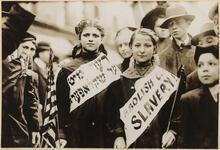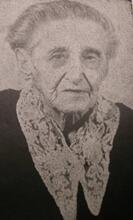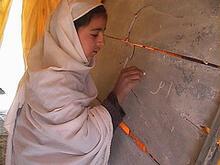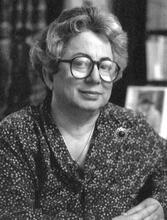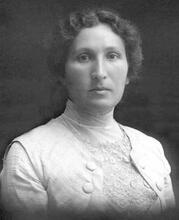Salonika: Female Education at the end of the Nineteenth Century
Salonika was a vibrant center of Sephardic Jewish life in the Ottoman Empire, at some points even boasting a majority Jewish population. The Alliance Israélite Universelle, a French Jewish educational program, was established to westernize, or in their words “regenerate,” Sephardi and Mizrahi Jewish communities. The Alliance established dedicated girls’ schools to give young Jewish women a secular education. Eventually, vocational schools were created for girls to learn embroidery and dressmaking. The remarkable development of educational activity for women in Salonika was reinforced by the social activities of middle- and upper-class women. These patrons also intervened in the area of moral education and encouraged the wealthier pupils to form a society dedicated to the redistribution of dresses, shoes and mo,ney to their poorer classmates.
The Alliance Israelite Universelle
From 1860, the Alliance Israélite Universelle took on the task of “regenerating” Eastern Jewish communities. Founded in Paris by a group of emancipated French Jews, the Alliance’s goal was to “offer effective support to those who suffer for being Jewish.” In order to achieve its aim of “working everywhere towards the emancipation and progress of Jews,” the Alliance concentrated on the creation of a vast educational network in the Balkans, the Near and Middle East, and in North Africa. Although its civilizing educational program—built largely on the secular Western model—was identical in all the newly founded institutions, the Jewish communities of the Ottoman Empire did not all benefit from it in the same way. Receptivity to the Alliance’s schools, and especially to their moral principles, depended on the level of development of the individual community and its social composition. The respective characters of these various communities were particularly evident in the area of education and emancipation of women. Female education was a key element of the Alliance’s program for the “regeneration” of Ottoman Jewish communities, and was the single most revolutionary agent of change in traditional communities.
The founders of the Alliance had clearly defined their principles: woman must be the equal of man, his companion in life. The education of girls was therefore seen as vital to the improvement of the condition of women in the Descendants of the Jews who lived in Spain and Portugal before the explusion of 1492; primarily Jews of N. Africa, Italy, the Middle East and the Balkans.Sephardi world. However, since the inculcation of moral values in children had always been the role of mothers, the Alliance intended to further elevate their role as educators. The instructions of 1903 are clearly insistent on this point (Rodrigue 1989, 80):
“To the qualities we hope to develop in all our children—rectitude, love of truth and the common good, goodness, devotion to others—must be added in girls a few special qualities; gentleness, modesty, simplicity of dress, the wish to shine other than through a ridiculous display of jewels and petticoats, a sense of the equality between rich and poor etc. [...]
The faults of character and education of women in the East and in Africa arise from a social condition already too old to be changed overnight; but women have such a marvelous gift of assimilation, and perceive subtleties so distinctly, that it will take relatively little time to secure good results, and we could not overstate this moral aspect of your task. We know that, in general, moral education holds a higher place in girls’ schools than in boys’, so these lines are designed only to encourage you to persevere along that path (AIU Circular 1903, 99).”
While several Jewish communities in these regions were reluctant to put the process of female emancipation into effect (Rodrigue 1989, 82–87), one is struck by the readiness of the Salonika community to adopt it. This reaction prompts investigation of the conditions favoring the institutionalization of female education in Salonika.
It is also interesting to examine the extent to which the Alliance managed to achieve its goal in Salonika. However, before evaluating the conditions that led the Salonika community to apply the female education program introduced by the Alliance, it is necessary to look at the place of women in the Jewish society of the day. (It would also be necessary to assess whether their position was different from that of women in other centers of the Ottoman world where Sephardic Jewish and Judeo-Arabic communities were more subject to the influence of Islamic society.) Salonika already stood out as a vibrant center of Jewish life, with a larger Jewish population than other cities in the eastern Mediterranean. At times, the population was even majority Jewish.
Women in Salonika
In fact, Salonikan women had little in common with their sisters in North Africa and the Near or Middle East, who were treated more or less as servants (Rodrigue 1989, 82–87). Although the Salonikan Jewish man was also the official head of the Sephardic household, he did not impose his “superiority” through conduct that was any more despotic than that of the contemporary Western man (Benveniste 1982, 13–26). Salonikan customs (Michael Molho 1950, 341) and literature (Sciaky 1946, 213)—which merit a study in their own right—reveal women in a very different role from that of a servant. The superiority of their social status, compared to that of Lit. "Eastern." Jew from Arab or Muslim country.Mizrahi women, is also confirmed by some revealing local proverbs, for example:
“Tanto es la reyna para el rey, tanto es la mujer para su marido.”
(As the queen is to the king, so is the wife to her husband.)
“El consenjo de la mujer es flaco, ma el que no lo toma es loko.”
(The advice of women is worth little, but only lunatics don’t follow it.)
“Al marido bueno dos cuernos; al negro tres y quatro.”
(Two horns for a good husband, three or four for a bad one.)
“Al marido como lo ambezades; al fijo como lo criates.”
(You train your husband, but you shape your son.) (Zografaki 1984)
It would therefore seem that in Salonika, and probably also in other large Balkan towns, women enjoyed a degree of respect from their husbands, despite being mostly poorly educated. Although their social status was relatively low, the proverbs suggest that they were nevertheless able to exercise some influence within their families.
The position of Orthodox Christian (Greek) women, who were their principal minority fellow-citizens, might have been considered at this time as preferable, since the Greek Girls’ School had been the first to be established in Salonika, in 1845 (Papadopoulos 1910). It is likely that some middle-class Jewish girls attended this school, though there are no sources earlier than 1891 to confirm this (Abatzidou 1994). It is also possible that Jewish pupils attended the school of the Sisters of St. Vincent, founded in 1855 (Hadjikyriaou 1910), since it is known that most of the pupils in the girls’ school founded in 1857 by a missionary couple named Crosby were Jewish (Nehama 1979, 666).
The Jewish community, despite being the largest (Molho 2001, 47–48), was doubtless subject to the influences of its multi-cultural environment. This is reflected in the consistency with which progressive community leaders used the Greek example to persuade donors to support them in establishing a girls’ school in Salonika (Allatini 1875). The presence of Jewish girls in Greek schools is also corroborated by the frequent gifts of Jewish benefactors, which continued even after the creation of the first private Jewish girls’ school by the Polish Countess Farnetti in 1867 (Nehama).
The progressive attitude of Salonika’s Jewish middle classes towards female education is confirmed by their promptness in establishing a girls’ school after the creation of the first modern boys’ school in 1873, with the support of the Alliance. Also thanks to the Alliance, the community opened the girls’ school on September 5, 1874 (Caro 1876). This new institution became one of the first half-dozen schools created with the same aim by the organization after 1868.
The Location and Development of the School
From the start, the decision to locate the girls’ school in a building adjoining the boys’ school was a sign of its progressiveness. During their second year of existence, the two new schools re-located to the first floor of a conak acquired by the President of the Local Committee, Moise Allatini, with funds donated for its purchase.
From 1874 to 1889 the girls’ school was run by Stella Orvieto Caro, an Italian Jewish teacher. This choice may be attributed to the influence of Salonika’s original Jewish aristocracy, which was distinguished by its Italian culture. In her reports to the Alliance she seems to have paid particular attention to the numbers of pupils enrolled. At first the school had 105 pupils, probably divided into two classes. In the course of the second year the roll swelled by forty-nine new pupils. By 1879 the total had reached two hundred—a growth of eighty-six pupils in five years. Fourteen years later, in 1898, the number of pupils exceeded three hundred, in six classes, of whom 163 paid fees and 139 were exempt. Finally, in 1912. with 630 pupils of whom 183 were exempt, the school was the fourth largest supported by the Alliance in the Eastern Jewish world, after Constantinople with 853 pupils. Adrianople with 790 and Baghdad with 785. It should however be noted that according to Table 1, drawn up to compare the position of education in the seven most important Jewish communities of the Empire in 1912, Salonika had the largest number of girls’ schools—twice as many as its boys’ schools—with a higher number of pupils enrolled.
| Boys' School | Girls' School | Girls' Training | ||||||
|---|---|---|---|---|---|---|---|---|
| City | Jewish Population | Founded | Pupils | Founded | Pupils | *FP/E | Founded | Pupils |
| Adrianople | 20,000 | 1867 | 1,099 | 1870 | 790 | 447/343 | ||
| Baghdad | 50,000 | 1865 | 731 | 1893 | 788 | 384/404 | 1890 | 126 |
| 1902 | 337 | 1909 | 248 | 67/217 | ||||
| Istanbul | 65,000 | 1874 | 510 | 1877 | 502 | 361/141 | 1908 | 9 |
| 1875 | 690 | 1879 | 853 | 405/448 | ||||
| 1879 | 217 | 1880 | 288 | 202/68 | ||||
| 1879 | 226 | 1882 | 301 | 233/68 | ||||
| Jerusalem | 40,000 | 1882 | 286 | 1906 | 358 | 187/171 | ||
| Salonika | 90,000 | 1873 | 912 | 1875 | 630 | 447/183 | 1887 | 369 |
| 1897 | 300 | 1897 | 130 | 100/30 | 1910 | 240 | ||
| 1897 | 230 | |||||||
| 1910 | 1,064 | |||||||
Details which are not revelant to the present study have been omitted.
*FP = Fee paying ; E = Exempt
Table 1: 1912 statistics on Jewish girls' and boys' primary schools founded by the Alliance in the seven largest Jewish communities in the Ottoman Empire.
Courtesy of Shalvi Publishing Ltd.
As the table makes clear, Salonika’s Jewish community was distinguished among other communities by a better distribution of poor girls in vocational schools, while the number of non-fee-paying girls in primary schools seems to have been lower. Since attendance at vocational schools was virtually free, the high number of Salonikan apprentice girls can only be taken to imply their intention of following a trade at the end of their studies. In the absence of figures on the number of women practicing various trades, one can deduce that parents in Salonika seem to have been concerned to ensure the vocational education of their daughters. In this respect they differed significantly from their coreligionists in other communities of the Ottoman world.
Table 2 analyzes the percentage of the female population of school age attending primary school, alongside the percentages of educated women in the same communities.
According to Table 2, Salonika lay in third place so far as the number of girls in school and of educated women was concerned. However, it is not possible to state that these figures represent an objective reality, since we do not possess precise figures on the number of girls attending co-educational schools that were subsequently created. On the other hand, it is likely that additional sources referring to the number of pupils attending private girls’ schools in Salonika would alter our calculations, if comparable sources existed for the private Jewish schools of other cities. Whatever the case, the high number of 695 girls in the fourteen private Jewish girls’ schools in 1895 is recorded in Table 3.
Female Education
To return to primary schools, it should be understood that until 1889, when French was officially introduced in the first girls’ school in Salonika, the language of teaching was Italian. Pupils with no prior knowledge of French learned the spoken and written language, together with handwriting, arithmetic, mythology and history, cosmography, and Judeo-Spanish; then, a little later, the basics of Hebrew, and finally drawing and singing. Pupils with a prior knowledge of French studied it from the second year on. Until then, apart from the study of Turkish, the program was identical with that of the boys, indeed to the point where it attracted the criticism of the Central Committee. Precise instructions were handed down to the head teacher. The Committee asked that the time allocated to science education be reduced from five hours to two in the upper classes. In keeping with the spirit of the age, which distinguished between the social roles of the sexes, the secretary wrote that girls needed only a very basic grounding in this field. Apart from this, the female curriculum differed from the boys’ in including sewing and embroidery lessons and, later, classes in the education of women and children, in decoration and in ironing—all areas of knowledge which, according to the views of the time, were “necessary for girls destined for motherhood.” However, from 1879, dressmaking was taught in the same school, now equipped with workshops and professional staff to train seventeen apprentices. Not long after, linen, lace, and embroidery workshops were also established (Nehama). The success of poor girls in establishing themselves and earning their living comfortably led the local Committee to create a proper training school.
Schools and Vocational Training
In the new school, developed from 1887 onwards and termed “Young Women’s Workshop,” students could learn sewing, embroidery, millinery, and the manufacture of brassières and dresses, as well as acquiring a general education. The most capable were trained as workshop overseers. A public exhibition of needlework took place at the end of the year. Of course, the workshop could meet the educational needs of only a tiny number of the girls of poor families. The miserable position of poor girls who were led to convert to Islam—or more often to life as a “working girl”—triggered private initiatives.
Social Activity Becomes Involved in Female Education
In 1896 a number of Salonika Jews addressed the problem of educational and employment opportunities by founding a benevolent society called “Toferet Yisrael” (Seamstress of Israel), with the aim of offering a craft training to poor girls as “a sign of gratitude for the work of the Alliance.” Having won the support of the Alliance, the Toferet soon transformed itself into a small apprenticeship school, with preparatory classes and workshops. (Its students even earned small salaries which the local Committee placed in the savings bank on their behalf. At A seven-day festival to commemorate the Exodus from Egypt (eight days outside Israel) beginning on the 15th day of the Hebrew month of Nissan. Also called the "Festival of Mazzot"; the "Festival of Spring"; Pesah.Passover, according to custom, dresses were given to all the pupils.)
In 1897 the popularity of these apprenticeship schools led the Alliance to establish two so-called “Popular” Girls’ Schools in the new suburbs of Hirsch and Calamaria. A second, exclusively vocational, school, known as the “Nouvelle” (New), opened in 1910. (In 1904, the only girls’ school established by the community promptly placed itself under the umbrella of the Alliance.)
The remarkable development of educational activity for women in Salonika was reinforced by the social activities of middle- and upper-class women. This is evidenced by the solidarity with which the ladies of the local Committee supported Stella Caro during the period of her tenure, from 1874 to 1889. These women visited the school systematically in turn, twice a week, and met monthly to plan improvements in the teaching and the premises. These patrons also intervened in the area of moral education and encouraged the wealthier pupils to form a society dedicated to the redistribution of dresses, shoes and money to their poorer classmates. Through societies such as the Bienfaisance (Benevolence 1891, the Tifereth or Association d’anciennes élèves de l’Alliance (the Association of Former Pupils of the Alliance, 1899), they took on the supervision and financing of poor girls, serving as role models to the pupils, with whom they maintained close relationships.
Did the Alliance Achieve Its Goal in Salonika?
For their part, the pupils through their diligence contributed to the progress of education and achieved remarkable results. A mere two years after the establishment of the elementary school in 1876, four of the 165 pupils qualified to participate in the Baron Maurice de Hirsch (1831–1896) scholarship contest. The progress made by pupils had also attracted the attention of authorities such as Jean Pantassidis, Professor of Philosophy at the University of Athens, and of Chevalier Michele, inspector of the Italian schools in Turkey. Both visited the institution to study the teaching methods introduced by the Alliance. The real moral influence of the school was an important aspect of its work: the young girls who attended were remarkable in their dress and manners. As early as 1879 the head teacher recognized that they had acquired all the qualities subsequently mentioned in the circulars of 1903:
“They are clean, modest, do not venture any proposition nor any reprehensible overture, speak in a submissive tone and in measured terms, and those who have left school continue to bring satisfaction to their families.” Stella Caro also reported with satisfaction that this moral influence had its effect on the behavior of parents conscious of the superiority of their educated daughters.
Since this development had also contributed to the improvement of relations between Jews and Greeks, it could, according to Stella Caro, bring about a transformation of social structures. Archbishop Joachim and M. Allatini jointly encouraged friendship between the ethnic communities, inviting people to send their children to schools of the other faith. They liked to say that churches and synagogues were the only places where the religions should stay separate. Impressed by this behavior, Stella Caro held Salonika up as a model city where the civilizing work of the Alliance could easily be reproduced.
Indeed, the particular nature of Salonika Jewish society, exposed as it was to the progressive ideas of female education held by its Greek neighbors, was closely linked to local conditions. If there was still a place where it is certain that Jews did not suffer for their Jewish identity, it was undoubtedly Salonika. On the other hand the ease with which Salonikan Jewish society accepted and encouraged the new model of womanhood can only be explained by its compatibility with the local, traditional model. Although neither the Sephardic woman of Salonika nor her Greek sister had won complete equality with their husbands, at least they both subscribed to the model of equality promulgated by the Alliance. But if school drew young women out of their closed environments, it was so that they could return to it as accomplished mothers. The thinking of the Alliance, in common with that of the age, conceived of female education and its resulting emancipation only in the context of social usefulness. It is true that the progressive spirit of the Alliance contributed to the development of social manners and helped Salonika Jewesses approach the intellectual level of their husbands. Previously left in their ignorance, they had had no active role outside the family. But until the vocational emancipation of women in Salonika has been more fully studied, it would appear that the widespread education offered by primary schools succeeded in modernizing Sephardic women only to the extent illustrated by this song from the 1930s.
Con un cante muy alegre vos vo a dizir
Si querech sintir por vos divertir
Mi embolios de familla cuandos eyos son
Papico con mamica a su fason:
Mama quere rami i sin querer permi
Papa por s’escusar la toma a caresar
Diz de la hupa que sufre mi papa
Es un sinema lo de mi mama
Los caprichos que tiene mi madre
Al comple se los paja mi padre
Sin azer djuzgar lo de mi mama
Nunca con Papa so estan en pas
Mama es “toilette” y papa con siklet
Las vidas de sar son para papa.
Al dentiste cada dia mamica se va
Papa con torva traje zarzava
Se la munda, se la enchangua, se la aze hazir
Ma eya tiene siempre que dizir
Papa que es tito le paga el oto
Y por se descansar la toma caresar
Esto ve mama se aze egzijir
Povero papa no save que rijir
Le demanda demandos de palo
Cada noche teatros y balo
Sin azer djuzgar lo de mi mama
Nunca con Papa non estan en pas
Mama es “toilette” y papa kon siklet
Las vidas de sar son para papa.
Las faturas y los cuentos se van al buro
Papa me djuro que bayla horo
De ver lo que mama gasta para se vistir
De ver la sumas le toma batir
al trocar la sezon Papa piedre razon
Papa da sin contar, mama esta a demandar
Esto ve mama empessa a egzijir
Povero papa no save ke rijir
Le demanda demandos de palo
Cada noche teatros y balo
Sin azer djuzgar lo de mi mama
Nunca con Papa no estan en pas
Mama es “toilette” i papa kon siklet
Las vidas de sar son para papa.
With a cheerful song I shall describe
My family troubles to entertain you.
Little Papa and little Mama: each has his ways.
Mama loves the rummy and plays without leave;
Papa to excuse himself gives her a caress.
Ever since they married, Papa suffers;
You should see the performance that Mother puts on:
It’s Father who pays for her whims in the end.
I won’t speak ill of my Mama’s ways
But I can say life’s no picnic for Papa.
For Mama it’s dressing up and for Papa it’s worries:
The problems of life are really just for him.
Every day my dear Mama trots off to the dentist.
Papa has to carry the bags of vegetables,
Peels, washes, prepares and cooks them for her.
But Mama, as usual, grumbles all the same.
Papa, who’s generous, pays for a taxi,
And to get some peace, he takes her in his arms.
When Mama sees that, she becomes demanding;
My poor little Papa doesn’t know what to think.
She makes completely unreasonable demands,
Like going nightly to the theater or a dance.
But I can say life’s no picnic for Papa.
For Mama it’s dressing up and for Papa it’s worries:
The problems of life are really just for him.
Her bills and accounts all arrive at the office.
My Papa swears it drives him nuts to see
What Mama spends on dressing up:
When he adds it up, his heart begins to hammer.
When seasons change he goes off his head.
He gives without restraint, but it’s never enough,
Mama’s always demanding that much and more.
My poor little Papa doesn’t know what to think.
She makes completely unreasonable demands,
Like going nightly to the theater or a dance.
But I can say life’s no picnic for Papa.
For Mama it’s dressing up, and for Papa it’s worries:
The problems of life are really just for him.
(Judeo-Spanish version of a French song by George Milton entitled Les vieux pyjamas c’est pour ma maman. Information and text provided by the late David Benbassa, entrusted to him by the late M. Beruhiel-Saidon. English translation by François Matarasso. The assistance of Robert Pring-Mill in producing this transcription is gratefully acknowledged.)
Benveniste, Annie. “Le rôle des Institutrices de l’Alliance à Salonique.” Combat pour la diaspora 8 (June 1982): 13–26.
Balkan Studies 34/2, 259–269.
Molho, Michael. Usos y constumbres de los Sefardies de Salonika. Madrid-Barcelona: 1950.
Molho, Rena. I Evraioi tis Thessalonikis, 1856–1919. Mia idiaiteri koinotita (The Jews of Thessaloniki, 1856–1919. A Particular Community), in Greek. Athens: 2001, 47–48.
Rodrigue, Aron. De l’instruction à l’émancipation, Paris: 1989, 80.
Anonymous. A.I.U., Instructions générales pour les professeurs. Paris: 1903, 99.
Zografaki, Georgiou K. Parimies ton evraion sefardi tis Ellados (Proverbs of the Sefardic Jews of Greece), edited by Dodoni, 23–27. Thessaloniki: 1984, proverbs 377, 245, 265, 298.
Papadopoulos, Stephanos I. Ekpedeftiki kai kinoniki drastiriotita tou ellinismou tis Makedonias kata ton telefteo eona tis Tourkokratias (The Educational and Social Activity of Hellenism during the Last Century of Turkish Rule). Thessaloniki: 1970, 99.
Abatzidou, Vassiiia. “I periptosi tis Astikis Scholis Thileon Thessatonikis” (Le Cas de l’Ecole Normale des Filles de Thessalonique). In Ta ellinika scholia sti Thessaloniki kata tin Tourkokratia, Actes du Colloque (The Greek Schools of Thessaloniki during the Last Century of Turkish Rule). Thessaloniki: 1994, 179–87.
Hadjikyriakou, Georgiou. Odigos tis Makedonias (Guide to Macedonia). Athens: 1910, 29–31.
Nehama, Joseph. Histoire des Israélites de Salonlque, vol. 7, Thessaloniki: 1979, 666.
Allatini, Moïse. A Sketch of the Primary Education among the Jews of the East and especially among the Jews of Salonika. London: 1875.
Archives of the Alliance Israelite Universeile, report by Stella Caro dated April 18, 1876.
Arch. de l’A.I.U., Greece, X/E145, reports of Stella. O. Caro: April 18, 1876, July 9, 1879, August 29, 1883, July 29, 1884, September 21, 1887, April 6 and June 11, 1888.
Reply of the Secretary of the Central Committee addressed to St Caro, dated November 1884.
Rodrigue, A. op. cit, Table II, 24–30. According to this table the first communities to receive schools were Tetouan In 1868, Adrianople in 1870, Choumla, Larasche and Tangiers In 1874. It should be noted that Rodrigue, who compiled his table by correcting that drawn up by P. Silberman. His study An Investigation of The Schools Operated by the Alliance Israelle Universelle from 1860–1940, doctoral thesis, University of New York, 1973, 248–254, omitted a correction of the date of the founding of the first school in Salonika, which he puts as 1875. (Translated from the French “L’activité éducative et sociale des femmes dans la communauté Juive de Salonique à la fin du 19ème slècle” by François Matarasso)



